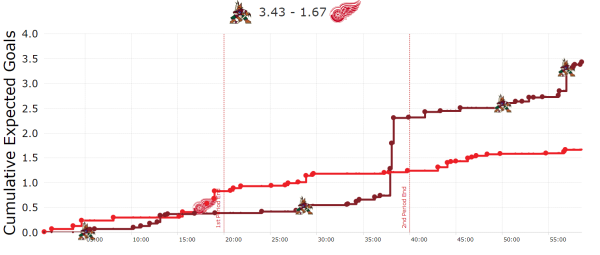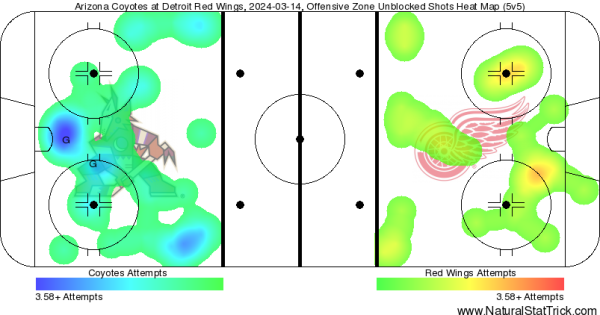
A statistical review of the Detroit Red Wings' 4-1 loss to the Arizona Coyotes on Thursday, featuring details on power play struggles, defensive mistakes and a few players who slightly improved compared to the rest of this seven-game losing streak.
A statistical review of the Detroit Red Wings' 4-1 loss to the Arizona Coyotes on Thursday, featuring details on power play struggles, defensive mistakes and a few players who slightly improved compared to the rest of this seven-game losing streak.

By the time the Arizona Coyotes scored an empty-netter to take a 4-1 lead over the hosting Detroit Red Wings, the home crowd had seen enough.
For the seventh straight game, the Red Wings lost. For the seventh straight they were outplayed. Trash patch talisman or not, they had completely collapsed during a season that up to a couple weeks ago included an almost certainty to make the playoffs. And in this game, against the Coyotes, Detroit didn’t have much to hang its hat on.
Let’s review the stats.
The Big Picture
Detroit wanted a better defensive effort against Arizona, and for the larger part it got that through two periods. Despite not generating a whole lot of scoring threats, the Red Wings stayed ahead 1.214-0.742 in expected goals until the waning moments of the second period. But that’s a little deceiving. When Arizona scored its first goal, Detroit became very tentative, scrambling for the puck and playing without poise as opposed to really controlling play.

By the end of the game, when the Coyotes scored two more goals in the third period, the Red Wings trailed 3.43-1.67 in all situations expected goals as tracked by Moneypuck. Detroit’s best chances, no doubt, came on the power play, but they weren’t enough to take control of the game. This game was also a worse outing than the Red Wings' 4-0 loss at Arizona last Friday, when they generated more chances but didn't convert.
At 5-on-5, the numbers were much more favorable to the Red Wings. The Coyotes led this statistic 1.33-1.11 by the night’s end, but Detroit was ahead until the final seven minutes. However, this also illustrates a problem. The Red Wings generated just 0.56 expected goals on the power play despite getting four chances early on. They scored one, while giving up a shorthanded goal on another, but the overall lack of attempts suggests that the power play had its issues. At a time when offense is already hard to come by for Detroit, such a struggle is just another straw on the camel’s back.
The location of these shots matters, because as much as the Red Wings took their shooting opportunities, they didn’t generate a whole lot from high danger areas. The Coyotes protected their net front well, meanwhile Detroit’s was undefended according to this heat map from Natural Stat Trick.

This map is the visualization of the defensive problems Detroit coach Derek Lalonde has mentioned as of late. By bleeding high danger chances, the Red Wings can’t control games the way they need to. Especially against a weaker Arizona team, such a performance is a frustrating continuation of Detroit’s struggles.
Individual Impacts
No Red Wing generated more than 0.43 expected goals on their shooting opportunities, and that high water mark belongs to forward Alex DeBrincat. Seemingly demoted to the third line, instead Detroit played him, Andrew Copp and Robby Fabbri more than any other combination at 5-on-5. DeBrincat has yet to score a goal in this losing streak, and he’s only got one assist to his name in that span. However, he’s been a consistent source of offense for a team that’s struggling to keep its head above scoreboard water.
But that line also followed the same pattern of defensive irresponsibility that Lalonde wants to weed out. DeBrincat’s lines barely out-chanced the Coyotes 0.448-0.445 while on the ice. The exact numbers don’t matter so much as the theme — they gave up offense to generate some, and that’s not how Detroit wants to play right now.
In what’s probably not a huge surprise, the most reliable line of the night was Michael Rasmussen, Joe Veleno and Patrick Kane. The trio generated a 0.162-0.029 edge in expected goals, while also clocking an 88.9% Corsi. Only two other lines — DeBrincat and Kane with J.T. Compher, as well as Compher with Kane and Lucas Raymond — generated a positive Corsi percentage meaning they out-attempted their opponents on the ice.
Defensively, Lalonde came in with a brand new look for his pairings, but that experiment lasted just a few shifts. Instead, he relied on the typical defense pairings he’s used most of this season. Reunited after some changeups, Ben Chiarot and Jeff Petry played the most of anyone at even strength and were the only pairing to generate a positive expected goals rate. Considering their last outing was a dash-five disaster class in Buffalo, such an outing is an encouraging sign.
And in net, Alex Lyon had a much better night than his previous outings, in part due to the team playing better in front of him. While Thursday marked his seventh game with a save percentage south of .900, he gave up just the three goals expected of him from where the Coyotes were shooting. That included stopping three high danger chances from Arizona at even strength, though he did let in a Logan Cooley breakaway for a shorthanded goal. Lyon’s performance was average, but that’s an improvement on the past span of games.
Overall, the Red Wings left a lot to be desired in their performance against the Coyotes. They made a handful of individual improvements, but the product overall was still deeply flawed. If this loss is a stepping stone toward ending the streak, that’s a step Detroit nonetheless needs to take. But as the sting of a seventh straight loss seeps in, it’s progress that should’ve come a long time ago.
Also from THN Detroit
Despite Strong Game from Lucas Raymond, Red Wings Can’t Snap Losing Skid
"We've Just Lost that Confidence": Red Wings Losing Streak Hits Seven in Home Loss to Coyotes
Shuffled Lines Cast Copp Into New Role as Red Wings Desperately Need Results
How the Red Wings Can Get Back into Playoffs: A Coyotes-Red Wings Game Day Notebook
Red Wings Recall Austin Czarnik Under Emergency Conditions
Prospect Roundup: Simon Edvinsson Developing through Bigger Role in Grand Rapids
Red Wings’ Losses a Product of Poor Defensive Play Catching up with Them
